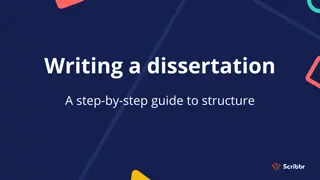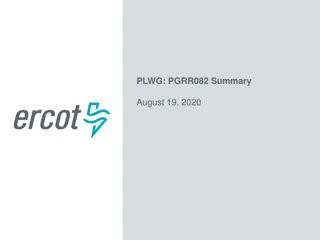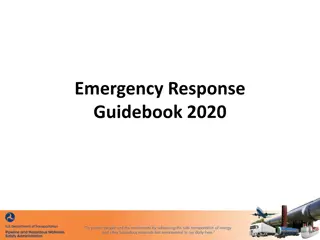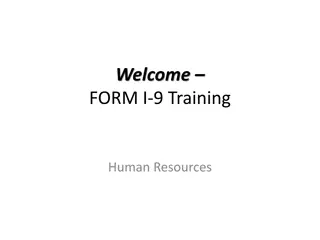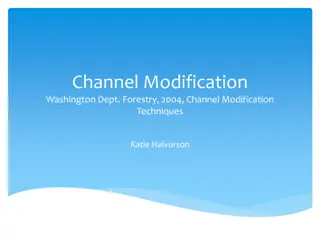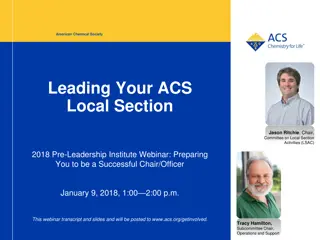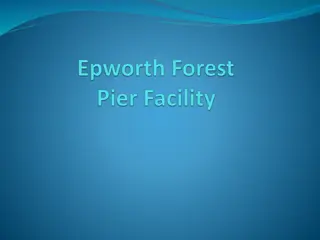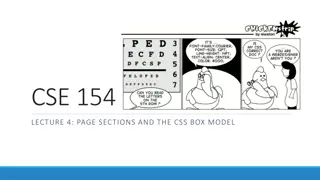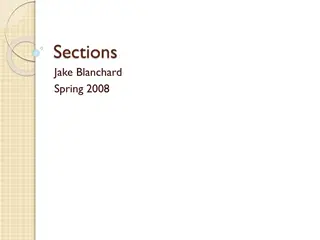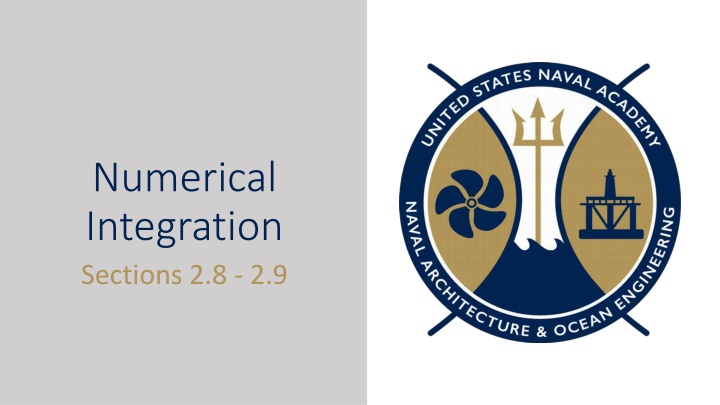
Numerical Integration in Ship Geometry and Design
Explore how numerical integration methods such as Simpson's 1st Rule are applied in calculating important geometric properties of ships, including waterplane area, sectional area, submerged volume, and more. Learn the steps involved in using numerical calculation for precise results in ship design.
Download Presentation

Please find below an Image/Link to download the presentation.
The content on the website is provided AS IS for your information and personal use only. It may not be sold, licensed, or shared on other websites without obtaining consent from the author. If you encounter any issues during the download, it is possible that the publisher has removed the file from their server.
You are allowed to download the files provided on this website for personal or commercial use, subject to the condition that they are used lawfully. All files are the property of their respective owners.
The content on the website is provided AS IS for your information and personal use only. It may not be sold, licensed, or shared on other websites without obtaining consent from the author.
E N D
Presentation Transcript
Numerical Integration Sections 2.8 - 2.9
Fundamental Geometric Calculation Why numerical integration? Ship is complex and its shape cannot usually be represented by a mathematical equation A numerical scheme, therefore, should be used to calculate the ship s geometrical properties Uses the coordinates of a curve (e.g. Table of Offsets) to integrate Which numerical method? Rectangle rule Trapezoidal rule Simpson s 1st rule (Used in this course) Simpson s 2nd rule
Numerical Methods Rectangle Rule Trapezoidal Rule Simpson s Rule Most accurate
Simpsons 1st Rule Uses series of 3 data points **must be an odd # of points, evenly spaced ** Assumes 2nd order polynomial curve Mathematical Integration y(x)=ax +bx+c y dx Numerical Integration y y1 y2 y3 dA A A x x s s x1 x2 x3 x1 x2 x3 (S= x) Area :
Simpsons 1st Rule y6y7 y y8 y9 y5 y2 y3 y1 y4 s s s s s s s s x x2 x3 x9 x1 x4 x5 x6 x7 x8 Odd Number, Odd Number, Evenly spaced Evenly spaced Gen. Eqn. =
Application of Numerical Integration in EN400 Calculate: Waterplane Area (Awp) Sectional Area (ASECT) Submerged Volume (?s) Longitudinal Center of Floatation (LCF) Vertical Center of Buoyancy (KB) Longitudinal Center of Buoyancy (LCB) Method: Simpson s 1st Rule
Numerical Calculation Calculation Steps: 1. Sketch and Label Start with a sketch of what you are about to integrate Show the differential element you are using (dx or dz) Properly label your axis and drawing 2. Write out the generalized calculus equation written in the same symbols you used to label your picture 3. Convert integral into Simpson s equation 4. Solve by substituting each number into the equation
Waterplane Area (Awp) Waterplane Area (Awp) ???= 2 ? ? ?? where integral is half breadths by station (Half-Breadth Plan) Y y(x) Half- Breadths (feet) dx=Station Spacing X 0 Stations
Waterplane Area (Awp) Reminders Use a Row in Table of Offsets for Awp Looking down Half- Breadth Plan (Multiply by 2) Steps (Half-Breadth Plan) Y y(x) 1. Draw Picture and D.E. Half- Breadths (feet) dx=Station Spacing 2. Calc EQN 3. Simpson s EQN X 0 Stations A. Constants in front B. dx ? 3 C. In front of dx Simpson s multiplier 4. Plug and Chug
Waterplane Area (Awp) Example Steps 1. Draw Picture and D.E. 2. Calc EQN 3. Simpson s EQN A. Constants in front B. dx ? 3 C. In front of dx Simpson s multiplier 4. Plug and Chug
Sectional Area (ASECT) Sectional Area (ASECT) ?????= 2 ? ? ?? where integral is half breadths by waterline Z (Body Plan) dz=Waterline Spacing y(z) Waterlines Y 0 Half-Breadths (feet)
Sectional Area (ASECT) Reminders Use a Column in Table of Offsets for Asect Body Plan Underwater portion only FB and B Steps Z (Body Plan) 1. Draw Picture and D.E. dz=Waterline Spacing 2. Calc EQN y(z) Waterlines 3. Simpson s EQN A. Constants in front Y B. dz ? 0 Half-Breadths (feet) 3 C. In front of dx Simpson s multiplier 4. Plug and Chug
Sectional Area (ASECT) Example Steps 1. Draw Picture and D.E. 2. Calc EQN 3. Simpson s EQN A. Constants in front B. dz ? 3 C. In front of dx Simpson s multiplier 4. Plug and Chug
Submerged Volume (?s) Submerged Volume (?s) ?s = ??????? where integral is sectional areas by station Asect A(x) Sectional Areas (feet ) X 0 Stations
Submerged Volume (?s) Steps Reminders Integrating Asect over LPP 1. Draw Picture and D.E. Asect A(x) 2. Calc EQN Sectional Areas (feet ) 3. Simpson s EQN A. Constants in front B. dx ? 3 C. In front of dx Simpson s multiplier X 0 Stations 4. Plug and Chug For this, either given Asect for stations or Asect curve
Submerged Volume (?s) Example Steps 1. Draw Picture and D.E. 2. Calc EQN 3. Simpson s EQN A. Constants in front B. dx ? 3 C. In front of dx Simpson s multiplier 4. Plug and Chug For this, either given Asect for stations or Asect curve
Remember Center of Floatation (F)? Center of Floatation (F) What is it? Centroid of the waterplane Why is it important? Pivot point for list/trim Describe it? LCF - distance from amidships, x-axis TCF - distance from centerline, y-axis We are now going to solve for LCF, using Simpson s Rule!
Longitudinal Center of Floatation (LCF) X component of centroid of waterplane area Distance from reference point to center of floatation Referenced to amidships or FP Sign convention of LCF Always (+) if referenced to FP (+) or (-) if referenced to amidships (+) if forward of amidships (-) if aft of amidships + WL - + FP
Longitudinal Center of Floatation (LCF) Longitudinal Center of Floatation (LCF) 2 ? ? ? ?? ??? = ??? where integral is product of distance from FP & half breadths by station (Half-Breadth Plan) Y y(x) Half- Breadths (feet) dx=Station Spacing X 0 Stations
Longitudinal Center of Floatation (LCF) Steps Reminders NOT same as F, it is a distance longitudinally from amidships or FP Centroid of AWP Row on table of offsets for Y Xo = FP = 0 X1 = Xo + x (Half-Breadth Plan) Y 1. Draw Picture and D.E. y(x) 2. Calc EQN Half- Breadths (feet) dx=Station Spacing 3. Simpson s EQN X A. Constants in front B. dx ? 3 C. In front of dx Simpson s multiplier 0 Stations 4. Plug and Chug
Longitudinal Center of Floatation (LCF) x6 x5 x4 y x3 x2 x1 x 0 1 2 5 6 FP 3 4 AP 2 ? ? ? ?? ??? = ???
Longitudinal Center of Floatation (LCF) Example Steps 1. Draw Picture and D.E. 2. Calc EQN 3. Simpson s EQN A. Constants in front B. dx ? 3 C. In front of dx Simpson s multiplier 4. Plug and Chug
Vertical Center of Buoyancy (KB) This is similar to the LCF in that it is a CENTROID, but where LCF is the centroid of the Awp, KB is the centroid of the submerged volume of the ship measured from the keel Where: Awp is the area of the waterplane at the distance z from the keel z is the distance of the Awp section from the x-axis dz is the spacing between the Awp sections, or Dz in Simpson s Eq.
Remember Center of Buoyancy (B) Center of Buoyancy (B) What is it? Centroid of the submerged volume Why is it important? Buoyant force acts through it Describe it? LCB - distance from amidships, x-axis TCB - distance from centerline, y-axis KB - distance from keel to B, z-axis We are now going to solve for LCB, using Simpson s Rule!
Longitudinal Center of Buoyancy (LCB) Steps Reminders NOT same as B, it is a distance longitudinally from amidships Centroid of Underwater Portion Asect given on table / graph Xo = FP = 0 X1 = Xo + x Z (Body Plan) 1. Draw Picture and D.E. dz=Waterline Spacing 2. Calc EQN y(z) Waterlines 3. Simpson s EQN A. Constants in front B. dx ? 3 C. In front of dx Simpson s multiplier Y 0 Half-Breadths (feet) 4. Plug and Chug
Key Reminders Body Plan ASECT VSUBMERGED (?s) LCB Where FB Acts Half Breadth Plan AWP LCF Table of Offsets: Row (at one waterline) AWP Column (at one station) ASECT
and that is Simpsons Equations as they apply to EN400! Remember: The concept of finding the center of an area, LCF, or the center of a volume, LCB, are just centroid equations. Understand THAT concept, and you can find the center of any shape or object! Don t waste your time memorizing all the formulas! Understand the basic Simpson s 1st, understand the concept behind the different uses, and you ll never be lost!





